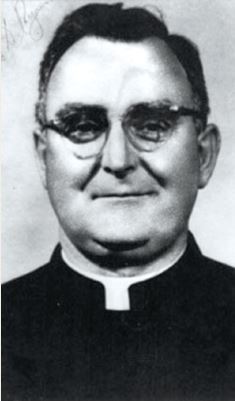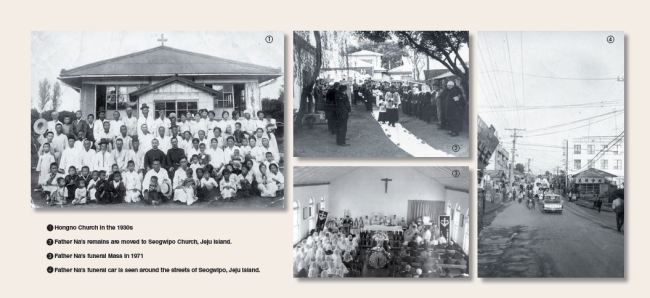[Foreigners Who Loved Korea] Father Na, friend of the people of Seogwipo
By Korea HeraldPublished : Jan. 3, 2017 - 18:40
In Korea’s turbulent path toward independence and nation building, there were foreign nationals who stood steadfastly by the Korean people, although their contributions have been largely overshadowed by those of Korean patriots. The Korea Herald, in partnership with the Independence Hall of Korea, is publishing a series of articles shedding light on these foreigners, their life and legacies here. This is the 23rd installment. -- Ed.
Thomas Ryan was born in Crossmolina, a town in County Mayo on the River Deel in Ireland, bordered by Lough Conn to the north. Since most of Ireland was Catholic, Thomas also believed in Catholicism from a young age. A sincere believer, he came to know of Korea when he became the priest of the Missionary Society of St. Columban in 1933.
Thomas Ryan was born in Crossmolina, a town in County Mayo on the River Deel in Ireland, bordered by Lough Conn to the north. Since most of Ireland was Catholic, Thomas also believed in Catholicism from a young age. A sincere believer, he came to know of Korea when he became the priest of the Missionary Society of St. Columban in 1933.

Encountering a Korea under colonial rule
Ryan naturally became a priest at the Missionary Society of St. Columban after graduating from St. Columban Theological Seminary. The following year, he was appointed as priest of the Hongno Roman Catholic Church in Seogwipo, and inaugurated the “Seogwipo Diocese” period in August 1937 by establishing a parish church and parsonage on Jeju Island.
In the midst of his activities, he was arrested and imprisoned by Japanese police on the charge of leaking Jeju military secrets.
After Korea was liberated, he briefly returned to his home country and was reappointed to Jeju Island. During the Republic of Korea’s land reform for constructing a new state, he was at the forefront of selling off part of the land owned by the Catholic church in Jeju. He also served as a military chaplain in the 1950s, and exerted efforts in relieving the refugees of Jeju Island while also carrying out activities to improve the welfare of its residents.

Settling in Jeju Island as an Irish missionary
The Missionary Society of St. Columban, which dispatched Thomas, was established in 1916 by the Irish priest Edward Galvin and was originally intended to missionize China.
Korea was also included as a country to missionize. In 1933, Ryan was dispatched along with nine other priests to Shanghai, China under the society’s order.
However, upon their arrival in Shanghai, they received a message telling them to go to Korea, and the 10 priests departed Shanghai for Korea on Oct. 27. After arriving in Nagasaki, Japan and riding the train to Shimonoseki, they arrived by boat in Busan on Oct. 29. The priests were taught Korean by Joseph Yun in Daegu’s St. Justino Theological Seminary for six months, they were then each dispatched separately to areas in South Jeolla Province on April 3, 1934.
At around this time, Ryan earned the moniker “Father Na.” He headed to Seogwipo in Jeju Island in 1934, serving as the priest of the Hongno Catholic Church starting that April. The missionary journal Far East published by the Missionary Society of St. Columban described the attitude the priests should take toward their followers, “The priests should match the attitude of the Korean martyrs, readily joining them on the path to martyrdom,” and “We pray that God will guide the youths who serve faithful Koreans to the Holy Spirit.”
After the 1916 Easter Rising and warring with England, Ireland declared its independence when 26 of its 32 counties voted to become a free country, according to the terms of the 1921 Anglo-Irish Treaty. Therefore, Irish priests understood better than anyone the emotions of Koreans under Japanese colonial rule. Father Na strove to help Korea become free in the belief that “Korea will not die, and will gain independence like our country Ireland.” Consequently, he moved the parish church from Hongno to Seogwipo in 1937.
Predicting the defeat of the Japanese
When Japan began the Pacific War in 1941 and formally joined World War II, the St. Columban priests who were from countries which Japan categorized as “hostile countries,” such as Australia, US, and New Zealand, were repatriated to their countries of origin. However, the Irish priests were kept under house arrest as they were regarded as belonging to “a semi-hostile country.” Subsequently, Father Na was charged with leaking Jeju’s military secrets and arrested that October. He was sentenced to two years in jail by the Gwangju District Court in 1942 for violating the infantry and navy penal codes. Father Na had told his followers Kang Bong-hae, Kang Kun-pyeong, Heo Muk, Kim Nam-gu and Dang Deok-yun that the news of Japanese victories was false, along with information of the Japanese military deployment. He had emphasized that the Japanese would inevitably lose.
The Gwangju District Court charged that “Father Na hoped for Japan’s defeat and held anti-Japanese sentiments.”
Father Na was imprisoned in Gwangju Penitentiary and was released due to illness in July 1943. After convalescing in Gwangju, he took a sabbatical in September 1946 and returned to Ireland.
Father Na’s account of his trial
What follows is Father Na’s account of his main statements in the trial:
The Japanese newspapers report as if the Japanese troops will achieve victory by themselves, although it is a total falsehood. If the United States and United Kingdom lend their support, prolonging the war, Japan will lose.
“The reason that Japan has established a volunteer enlistment system in Korea and is conscripting Koreans is because they lack Japanese troops due to the Second Sino-Japanese War.
If the Soviet Union attacks the Japanese islands with 50,000 planes at a time, then the Japanese troops will be defeated no matter how hard they resist.
If Germany loses this war against the United Kingdom, then Japan will meet with misery in the future.
If the United States and United Kingdom support China, then Japan will lose the war.
Thus Japan will never win. If the war is prolonged, Japan will be backed into a corner.
Organizing a relief movement during the Korean War
On Oct. 10, 1947, Father Na returned to Korea and became the 10th head priest of the Seogwipo Diocese. His legs were in such pain that he could hardly walk, but when a plan to seek treatment in the US was brought up, he refused and resolved to stay at his post.
In August 1950, the chief justice, chief prosecutor and other influential people of Jeju Island, numbering 16 in total, were arrested under the order of the Jeju Martial Law Headquarters on the charge of forming a North Korean People’s Army Welcoming Committee.
Father Na filed a petition to the relevant authorities and exerted efforts in safeguarding their civil rights. This was one part of his efforts to overcome the instability caused by ideological conflict.
At the time, he was also working as a military chaplain in the US 8th Army and showed a special interest in providing relief to Jeju’s refugees with the support of the National Catholic Welfare Council in the US. He passionately threw himself into educational activities by running a refugee school and opening Haeseong Kindergarten. In addition, he formed a choir made up of evacuated doctors and nurses working with the Red Cross Hospital and Catholic believers. He spared no effort in helping the poor and those suffering around him, despite the risks to his life imposed by war.
Father Na spent 21 years as the pastor of the Seogwipo Diocese on Jeju Island, from 1934 to 1952, and from 1967 to 1970.
In 1971, he passed away at Mokpo St. Columban Hospital and his body was moved to Seogwipo in accordance with his will that he be buried at Seohongri overlooking Seogwipo. After his funeral Mass at Seogwipo, his body was paraded around the city streets of Seogwipo, where he had long resided and considered his home. He was finally buried in the Seohongri Church Cemetery in Seogwipo. Catholics as well as the citizens of Seogwipo eulogized him. Afterward, his remains were moved to Hwangsapyeong Clergy Cemetery on Jeju Island, which held the bodies of Catholic martyrs who died in the Sinchuk Massacre in 1901.
Recognized for his passion for Korea’s independence
It was not until the late 1990s that the trial records of Father Na and other priests during the Japanese colonial period were discovered.
The Jeju Regional Office of Patriots and Veterans Affairs accepted the requests of the Jeju Church, civic groups, and academia to look into the matter. In 1999, it investigated the actions of those who had dedicated their lives to Korean independence.
It then requested the Korean government confer honors unto them. Finally, on the 54th anniversary of Korean liberation, Revs. Patrick Dawson (1905-1989) and Austin Sweeney (1909-1980) were recognized for their contributions, while Ryan was posthumously conferred the Order of National Pride. Father Na’s immense love for humanity crossed borders and his resolute attitude was a spiritual pillar to the Korean people in the midst of all manners of persecution.
By Kook sung- ha, National Museum of Korean Contemporary History
-
Articles by Korea Herald



![[AtoZ into Korean mind] Humor in Korea: Navigating the line between what's funny and not](http://res.heraldm.com/phpwas/restmb_idxmake.php?idx=644&simg=/content/image/2024/04/22/20240422050642_0.jpg&u=)
![[Exclusive] Korean military set to ban iPhones over 'security' concerns](http://res.heraldm.com/phpwas/restmb_idxmake.php?idx=644&simg=/content/image/2024/04/23/20240423050599_0.jpg&u=20240423183955)



![[Graphic News] 77% of young Koreans still financially dependent](http://res.heraldm.com/phpwas/restmb_idxmake.php?idx=644&simg=/content/image/2024/04/22/20240422050762_0.gif&u=)
![[Herald Interview] Why Toss invited hackers to penetrate its system](http://res.heraldm.com/phpwas/restmb_idxmake.php?idx=644&simg=/content/image/2024/04/22/20240422050569_0.jpg&u=20240422150649)






![[Exclusive] Korean military to ban iPhones over security issues](http://res.heraldm.com/phpwas/restmb_idxmake.php?idx=652&simg=/content/image/2024/04/23/20240423050599_0.jpg&u=20240423183955)



![[Today’s K-pop] Ateez confirms US tour details](http://res.heraldm.com/phpwas/restmb_idxmake.php?idx=642&simg=/content/image/2024/04/23/20240423050700_0.jpg&u=)